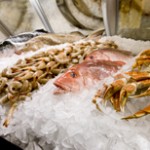by Dorothy C. Lee | Jul 17, 2013
 “It must be something I ate” often is the explanation people give for a bout of home-grown “Montezuma’s Revenge” or some other unwelcome gastrointestinal upset.
“It must be something I ate” often is the explanation people give for a bout of home-grown “Montezuma’s Revenge” or some other unwelcome gastrointestinal upset.
Despite the fact that America’s food supply is the safest in the world, the unappetizing truth is that what we eat can very well be the vehicle for food-borne illnesses. It is estimated that 76 million cases of food-borne illness occur in the United States every year.
The Food and Drug Administration has given high priority to combating microbial contamination of the food supply but part of the responsibility for preventing food-borne illness lies with the consumer. It is estimated that 35 to 40% of food-borne illness in the United States results from unsafe handling of food at home.
The prime causes of foodborne illness are a collection of bacteria with tongue-twisting names. These organisms can become unwelcome guests at potlucks, picnics, and the dinner table.
They are in a wide range of foods, including meat, eggs, milk and dairy products, coconut, chocolate, seafood, and even water.
Careless food handling sets the stage for the growth of disease-causing organisms. For example, hot or cold foods left standing too long at room temperature provide an ideal environment for bacteria to grow. Improper cooking also plays a role in foodborne illness.
Foods may be cross-contaminated when cutting boards and kitchen tools that have been used to prepare a contaminated food, such as raw chicken, are not cleaned before being used for another food, such as vegetables.
Symptoms
Common symptoms of food-borne illness include diarrhea, abdominal cramping, fever, and vomiting. However, symptoms will vary according to the type of bacteria and the amount of contaminants eaten. For most healthy people, food-borne illnesses are neither long-lasting nor life-threatening. However, they can be severe in the very young, the very old, and those whose immune systems are suppressed.
Prevention Tips
The idea that the food on the dinner table can make someone sick may be disturbing, but there are many steps you can take to protect your family and dinner guests. It is just a matter of following basic rules of food safety.
Prevention of food poisoning starts with your trip to the supermarket. Pick up your canned and packaged foods first. Don’t purchase food in cans that are bulging or dented, or in jars that are cracked. Look for expiration dates on the labels. Likewise, check the “use by” or “sell by” date on dairy products such as cottage cheese, cream cheese, yogurt, and sour cream. Pick the ones that will stay fresh longest in your refrigerator.
When choosing eggs, open the carton and make sure that none are cracked or leaking.
Place frozen foods and perishables such as meat, poultry, and fish in your cart last. Always put these products in separate plastic bags so that drippings don’t contaminate other foods in your shopping cart. Bag cold and frozen foods together, and if it will take more than an hour to get your groceries home, take along an ice chest to keep frozen and perishable foods cold.
Safe Storage
Be sure to refrigerate or freeze perishables as soon as you return from the grocery store. Refrigerator temperature should be 40°F or below and the freezer should be 0°F or below.
For foods that can be stored at room temperature, some precautions will ensure they remain safe.
Store potatoes in a cool dry place—not under the sink or in the refrigerator. Don’t store foods near household cleaning products and chemicals. When you are putting canned food items away, store the older canned items to the front and canned items with the longest-out dates of use in the back row so you’ll be sure to use the older ones first.
Keep It Clean
The first rule of safe food preparation is to keep everything clean. This rule applies to the areas where food is prepared and, most importantly, to the cook. Wash hands thoroughly before starting to prepare a meal and always after handling raw meat and poultry. Keep the work area clean. Wash fruits and vegetables thoroughly. Do not put cooked meat on an unwashed platter that has held raw meat.
The second rule of safe food preparation is keep hot foods hot and cold foods cold.
After the meal, leftovers should be refrigerated as soon as possible.
Here are a few more tips to keep your favorite dishes safe:
- Don’t thaw meat and other frozen foods at room temperature.
- Thaw in the refrigerator or microwave.
- Never taste food that looks or smells spoiled.
All these dos and don’ts may seem overwhelming, but remember: if you want to stay healthy, the old saying, “rules are made to be broken,” does not apply to food safety!
For further information regarding food safety and other related topics, go to the University of Florida’s Solutions for Your Life website: http://www.solutionsforyourlife.com.
Reference: Safe Food Handling Fact Sheets, United States Department of Agriculture, Food Safety and Inspection Service
by Dorothy C. Lee | Oct 24, 2012
 What you don’t know can hurt you. “I didn’t know.” In these words lies the story of countless deaths and injuries in countless homes.
What you don’t know can hurt you. “I didn’t know.” In these words lies the story of countless deaths and injuries in countless homes.
About one-half of the accidental deaths of children occur in the home— from falls, suffocation/choking, scalding, poisoning, and burning. Elderly persons, likewise, are subject to greater dangers because of infirmities and impaired faculties. Yet the concern about home accidents is not only for the very young or the very old. Accidents at home can strike people of all ages.
Every year, over two million poisonings are reported to Poison Control Centers across the country, and more than ninety percent of those happen in the home. The majority of non-fatal poisonings occur among children younger than six years, and poisoning is one of the leading causes of death among adults.
The medicine cabinet is a favorite attraction for curious young children. It is not enough to put poisons and certain types of medicines on high shelves because exploring children like to climb. Dangerous substances need to be locked up.
A significant number of children are being poisoned by consuming medicines brought into the home by grandparents or visitors. Poisonings also have occurred when youngsters have visited homes where no children live.
Substances which can cause accidental poisoning in children also are found outside the medicine cabinet. The list is a lengthy one—detergents, cleaning compounds, insect sprays, paint thinners, and antifreeze, just to name a few.
Children are not the only victims of accidental poisoning. Every year, there are numerous cases of men and women who poison themselves unintentionally. To help prevent a tragic accident in your home, follow safety-wise guidelines.
Keep household products separated. Take care that foods are not exposed and become contaminated when you use insect sprays, cleaning agents, and rodent poisons.
- Containers with flammable liquids should be clearly labeled.
- Flammable liquids such as gasoline should be stored in a cool, well-ventilated place, not inside the home.
- Never pour flammable liquids down sinks or other drains.
- Store medicines and cleaning supplies in locked cabinets out of children’s reach.
The Centers for Disease Control report that about 12,000 children every year are victims of poisonous plants or berries they have ingested, or in some cases, just put into their mouths. Most persons are reasonably familiar with dangerous outdoor plants, such as poison ivy, oleander, or deadly nightshade, but what they do not know is even some of the most common houseplants can cause serious, even fatal reactions. For example, tea brewed from mistletoe berries is lethal and rhubarb leaves (not the stalks) contain oxalic acid, which can cause severe kidney damage.
One home safety issue that is not well-publicized regards pressurized containers. Pressurized containers have revolutionized packaging economy, but caution is necessary in their use. Never incinerate a pressurized container. The heat will cause the air inside to expand, which, in turn, may cause the container to burst. Read the warning message on the container to find out if the mixture is flammable. Keep pressurized containers away from children.
Keeping home safety in mind at all times can mean the difference between a happy home environment and a tragedy.
Note: See the following article for additional information on home safety and children, http://www.nanny.net/blog/9-most-common-household-poisons/

by Dorothy C. Lee | Jul 25, 2012
This may sound like a fish story, but it’s true! People are eating more fish and shellfish than ever before! While seafood has always been popular in the South as a whole, no area is more graciously endowed with an abundance of fresh seafood products than the northern Gulf Coast. The warm waters of the Gulf of Mexico abound with many delicious saltwater fish, as well as a plentiful supply of shrimp, crabs, scallops, and oysters.
of shrimp, crabs, scallops, and oysters.
Fish and shellfish have become an even more important part of the diet as people turn to more healthful eating. People are choosing fish and shellfish more for several other reasons as well—it is economical, high in nutritive value, quick and easy to prepare, versatile, and, best of all, seafood is great-tasting.
Buying seafood can be a daunting process because of the huge variety of market forms available, yet with general guidelines you can easily learn to recognize quality and freshness.
Always purchase your fish and shellfish from a reliable dealer who will stake his reputation on the quality and freshness of his merchandise. Seafood is a highly perishable commodity, and therefore should be purchased as near to the time of preparation as possible, and as close to the time the catch was made, if that information is available.
When buying fish, look for bright, clear, bulging eyes; reddish or pink gills; tight, shiny scales; firm, elastic flesh that springs back when pressed; and a pleasant salt-water-like odor. Fresh shrimp should be slightly green in color and firm to the touch. Shucked oysters should be plump with no evidence of shrinkage. The liquid in which oysters are packed should be clean, fresh, and sweet-smelling. Scallops are usually sold shucked. Select scallops that are cream-colored rather than white.
Fish and shellfish are best if cooked the day of purchase, but can be stored no more than two days in the coldest part of the refrigerator, preferably on ice. Frozen fish and shellfish should be kept solidly frozen until ready to thaw. Frozen seafood will remain fresh for four to six months. Cook seafood immediately upon thawing. Never refreeze seafood.
Most fish and shellfish can be cooked using a variety of methods. Seafood can be broiled, grilled, deep-fried, poached, steamed, baked, panfried, and sautéed. Particular care must be taken not to overcook seafood.
Many seafood aficionados/enthusiasts prefer flavoring their dishes with only small amounts of salt, pepper, and occasionally lemon, yet the delicate taste of seafood blends exceptionally well with a variety of herbs, spices and seeds, as long as those seasonings are used sparingly so as not to overwhelm the flavor of the seafood.
So the next time you are in the neighborhood of your favorite seafood market, stop in. Remember that fish and shellfish from the Gulf are nutritious, economical, quick and easy to prepare, and taste great. And that’s no fish story!
SWEET-AND-SOUR SHRIMP
1 pound shrimp, cooked, peeled, and deveined
¼ cup margarine
1 onion, thinly sliced
1 bell pepper, diced
1 (8¼-ounce) can pineapple chunks
½ cup white vinegar
¼ cup white sugar
2 tablespoons cornstarch
1 tablespoon soy sauce
½ teaspoon dry mustard
1 teaspoon pepper
¼ teaspoon salt
Cut shrimp into bite-sized pieces. Heat electric wok to 350°F and melt margarine; cook onions and bell peppers until they are crisp-tender.
Drain pineapple, reserving syrup for sauce. In a large bowl blend together pineapple syrup, vinegar, sugar, cornstarch, soy sauce, dry mustard, pepper, and salt. Mix well. (Note: a whisk will aid in thoroughly blending ingredients.)
Stir sauce into sautéing onion and bell pepper; cook until sauce thickens. Gently stir in pineapple chunks and shrimp. Heat until pineapple and shrimp are hot. Serve over hot rice.
Author: Dorothy C. Lee, Family and Consumer Sciences Agent, UF/IFAS Escambia County Extension
 “It must be something I ate” often is the explanation people give for a bout of home-grown “Montezuma’s Revenge” or some other unwelcome gastrointestinal upset.
“It must be something I ate” often is the explanation people give for a bout of home-grown “Montezuma’s Revenge” or some other unwelcome gastrointestinal upset.


